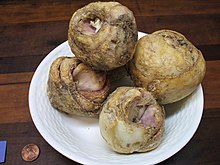Imperial crown (plant)
| Imperial Crown | ||||||||||||
|---|---|---|---|---|---|---|---|---|---|---|---|---|

Imperial crown ( Fritillaria imperialis ) |
||||||||||||
| Systematics | ||||||||||||
|
||||||||||||
| Scientific name | ||||||||||||
| Fritillaria imperialis | ||||||||||||
| L. |
The Kaiser crown ( Fritillaria imperialis ) is a plant from the genus of Fritillaria in the family of Liliaceae (Liliaceae). It's poisonous.
description
Vegetative characteristics
The imperial crown is a perennial herbaceous plant that reaches heights of 50 to 150 centimeters. This geophyte forms onions as persistent organs. The onions give off a noticeably strong odor, which many hobby gardeners believe is a deterrent to voles. The stem is leafy. The simple leaves are lanceolate and have parallel veins.
Generative characteristics
The flowering period extends from April to May. There is a tuft of leaves above the flowers . Three to six (rarely up to eight) flowers form a pseudo-whorl. The pendulous, hermaphrodite flowers are threefold and have a fox odor. Inside is a mother-of-pearl colored nectar gland with a diameter of 5 millimeters. The six identical, light to dark orange or yellow bracts are 40 to 55 (rarely up to 60) millimeters long. There are six free stamens . The pollination is done by bees.
The number of chromosomes is 2n = 24.
Occurrence
The imperial crown occurs in southeastern Turkey , northern Iraq , western and southern Iran , Afghanistan , Pakistan and Kashmir . It settles here on stony slopes and bushes at altitudes of 1250 to 3000 meters.
Systematics
The first publication of Fritillaria imperialis was in 1753 by Carl von Linné .
Of Fritillaria imperialis there are about two varieties:
- Fritillaria imperialis L. var. Imperialis (Syn .: Fritillaria imperialis corona Panz. , Fritillaria imperialis corona Gaertn. , Fritillaria imperialis var. Maxima Eeden , Fritillaria aintabensis Post , Fritillaria imperialis var. Rubra maxima auct., Fritillaria imperialis var. longipetala auct.): It occurs from southern and eastern Turkey to northwestern Iran and from Afghanistan to the western Himalayas.
- Fritillaria imperialis . Var kashmirensis Wietsma : This 2014 first described the variety is found in the western Himalayas.
Toxicity
Like most species of Fritillaria , the imperial crown is poisonous to humans. The onion in particular - but also the rest of the plant - contains a number of poisonous alkaloids , including fritillin and the steroid alkaloid imperialin, which can lead to circulatory problems, vomiting and cramps, and in high doses (especially in children) to cardiac arrest. For treatment to be antispasmodics administered.
use
The imperial crown is a common ornamental plant in borders and perennial beds . It is an ancient garden plant from the Orient. In Central Europe it has been in culture since 1573 at the latest. There are numerous varieties with yellow, orange or brick red flowers.
Selection:
- 'Prolifera' ('Crown on Crown'): light orange flowers in two wreaths one above the other
- 'Aureovariegata': white-yellow-edged leaves, brown-orange flowers
- 'Lutea maxima': yellow flowers
- 'Orange Billian': large, orange, brownish overflowing flowers, plant resistant
- 'The Premiere': early flowering period, orange-yellow flowers, purple nerves
In July 2011 it was chosen by the Dutch International Flower Bulb Center (IBC) as Flower Bulb of the Year 2011 .

Habit of a yellow variety
|
Philatelic
In addition to the permanent stamp series flowers , Deutsche Post AG issued a postage stamp worth 60 euro cents. The stamp shows a Fritillaria imperialis rubra. It was first published on December 5, 2013. The design was created by graphic designers Stefan Klein and Olaf Neumann in Iserlohn.
Common names
The other common German-language names exist or existed for the imperial crown : Kaiserkron ( Low German ), Königskron, Königslilien and Kronblume.
swell
literature
- Eckehart J. Jäger, Friedrich Ebel, Peter Hanelt, Gerd K. Müller (eds.): Excursion flora from Germany . Founded by Werner Rothmaler. tape 5 : Herbaceous ornamental and useful plants . Springer, Spektrum Akademischer Verlag, Berlin / Heidelberg 2008, ISBN 978-3-8274-0918-8 , pp. 682 .
Individual evidence
- ↑ a b gift plants.com
- ↑ Fritillaria imperialis at Tropicos.org. In: IPCN Chromosome Reports . Missouri Botanical Garden, St. Louis
- ↑ Fritillaria imperialis at Tropicos.org. Missouri Botanical Garden, St. Louis, accessed September 26, 2016.
- ↑ a b c Rafaël Govaerts (Ed.): Fritillaria imperialis. In: World Checklist of Selected Plant Families (WCSP) - The Board of Trustees of the Royal Botanic Gardens, Kew . Retrieved September 26, 2016.
- ↑ gartentechnik.de viewed on July 16, 2011
- ^ Georg August Pritzel , Carl Jessen : The German folk names of plants. New contribution to the German linguistic treasure. Philipp Cohen, Hannover 1882, p. 155 ( online ).




